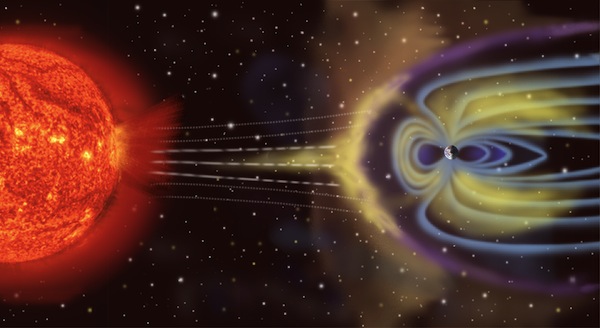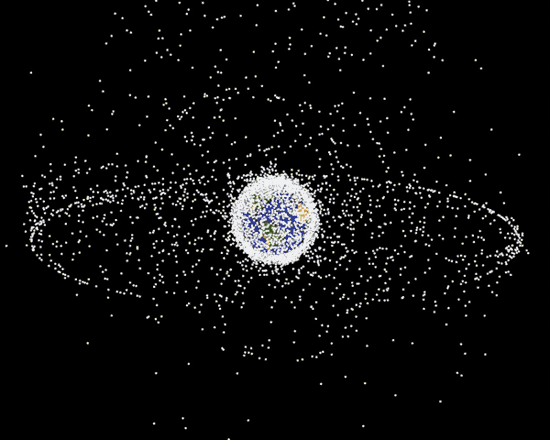The sun regularly emits charged particles – the solar wind – but sometimes huge quantities of them are released at once. It is not uncommon, but because space is so large it is rare for the Earth to be directly in the path of one of these “coronal mass ejections”. In September 1859 a solar flare sent a huge mass of charged particles directly at the Earth, inducing what “the largest geomagnetic storm on record”. The aurora, normally seen at the poles, extended so far south that it could be seen as far south as Cuba and Colombia. It also played havoc with the leading technology of the time, the telegraph system.
As hundreds of tons of magnetically charged particles smashed into the atmosphere, reports from the time describe the impact of the electric currents induced into the telegraph wires. Platinum contacts were in danger of melting and “streams of fire” were pouring forth from the circuits. In Washington, D.C. a telegraph operator was injured when his forehead grazed a ground wire. According to a witness, an arc of fire jumped from his head to the telegraph equipment. Some telegraph stations reported powerful surges that caused telegraph paper to combust.
The Earth has been relatively lucky since. The sun goes through cycles of approximately 11-year activity and quiet. According to the Solar Cycle 25 Prediction Panel, we began the 25th solar cycle at the start of 2020, after a relatively calm previous solar cycle. Now we can expect sunspot activity – the mark of solar storms – to ramp up towards a peak around 2025. Moreover, there is no agreement about how strong the activity in the coming cycle could be, with some predictions warning of some of the highest activity on record.
At its most active, the sun can launch two or three coronal mass ejections a day, with it being a matter of coincidence whether or not the Earth is in their path. However, according to Juha-Pekka Luntama, Head of ESA’s Space Weather Office, “it is important to remember that individual large solar events, huge flares and coronal mass ejections can happen at any point, independent of where we are in the solar cycle or how strong the cycle becomes.”
In other words, the Earth could be hit at any time by another event on the scale of September 1859, but the next few years provide an increased likelihood. In the past 160 years we have leapt forward in our use of electronic phenomena, and our dependency on the services they provide. Media, electric power, internet and communications services make for a wide suite of essentials in the modern age. How well prepared are we to cope if this happens?

Electricity Grids
The effect of a coronal mass ejection would induce currents into the metal wires of power grids. As with other geomagnetic phenomena, it would be felt most strongly towards the poles. Indeed, in 1989 a solar storm induced electrical currents in Quebec’s power grid, causing blackouts for an estimated six million people.
Unsurprisingly, this is a concern for electricity providers and their regulators, with more northerly countries preparing especially. Norway’s SINTEF research organisation has recently examined exactly this challenge. “For large storms, the only viable option today would be to turn everything off, i.e. cause a deliberate blackout to avoid damaging vital infrastructure,” noted Kristian Thinn Solheim in an article for SINTEF’s blog. “But what we really need are transformers, high voltage lines, power cables, and other components to withstand the impact of a solar storm.”
Part of the challenge lies with the difficulties in forecasting a solar storm hitting us. “About five days before a storm hits us, we may get some kind of indication,” Thinn Solheim observed, thanks to the observatories watching the sun already.
The problem is that – depending on the polarity of the particles in a coronal mass ejection it may cause chaos, or it may have no impact. There is currently no way to forecast that through our telescopes. Instead, space-based monitoring stations can identify this. They are, however, in orbit relatively close to the Earth. So – should we shut down or not? “We don’t know for certain until just one hour before impact,” Thinn Solheim explained. At the moment, most power stations need considerably longer to be safely switched off.
If any grid is still operating when a storm like 1859 hits, blackouts are likely, requiring a fresh start-up process afterwards. While many parts of the grid are protected against electrical surges, the transformers that convert high-voltage long distance lines’ energy into low-voltage power for home use could be at risk. These transformers can be “as big as a house, cost more than $10 million and take 12 to 18 months to replace” said David Geller, Senior Analyst at insurance company Verisk in this article.
Not surprisingly there are regulations being put in place to protect transformers from these effects. However, while these exist for the USA and some other countries, they are not universal.
Needless to say, for the time that we lack electricity – whether through a deliberate switch-off or failures – access to the internet, media, electric heating or cooling will also be affected. Batteries or back-up generators, for example with diesel, will last a certain time before they are depleted, but many people in urbanised environments will start to encounter larger problems after 24 hours. Ironically it may be more remote areas that do not rely on national power grids but on local generation – for example, small-scale wind or solar – that have more resilience in this situation.
Terrestrial Mobile Networks
Professor Sangeetha Abdu Jyothi of the University of California Irvine recently released a paper outlining the damage a solar storm could do to the global telecoms system. Most components of mobile networks should be able to survive relatively well under these circumstances, owing to the fact that most long cables in use today are fibre optic glass.
While the cables themselves are not magnetic and therefore not at risk, the major subsea cables connecting continents feature repeater stations that boost the optical signals, and these most definitely are. These rely on subsea power cables to keep them running and would be at risk of induced currents.
If some of these repeaters were to fail, countries or regions would be isolated until underwater repairs could be carried out. In some regions there are datacentres which can keep some services running locally – if the datacentres themselves survive well and have power – but many would lose access to some of the “internet fundamentals” such as Google or Facebook which would often be a first port of call for information and help. Surge protection devices, if installed, should protect the datacentres from harm.
Satellites
Not surprisingly, satellites would likely suffer considerably from a sizeable coronal mass ejection. In this case, NASA points out, “Either the satellite becomes highly charged during the storm and a component is damaged by the high current that discharges into the satellite, or a component is damaged by high-energy particles that penetrate the satellite.”
These particles do not reach the earth’s surface since they are mostly blocked by the atmosphere, but out above the atmosphere the electronic components in the satellites are vulnerable to damage.
This would not only affect communications directly, but could also threaten the global GPS system, which is used for locating objects and for managing the timing of services such as payments globally. A problem with GPS could have knock-on effects for global financial systems, navigation and more.
The outlook is worse for the new generation of Low Earth Orbit satellites such as Starlink or OneWeb a few hundred kilometres above the earth. As the charged particles hit the upper layers of the atmosphere, it will heat up and expand. This will increase the density of particles around objects in Low Earth Orbit, creating drag and slowing the satellites – which will start to fall towards the Earth. The International Space Station, roughly 300km up, regularly adjusts its height above the Earth to account for and avoid such fluctuations in the atmosphere. However, the tiny “cubesat” constellations have very little propellant, if any at all, to respond to an occurrence like this.

What to Do About This in Telecoms and Cloud?
Professor Abdu Jyothi gives the following advice for terrestrial infrastructure operators: “Similar to power grids, powering off is the easiest solution for equipment damage prevention. However, note that this only provides limited protection since geomagnetically induced currents can flow through a powered-off cable. Since the peak current is reduced slightly by powering off, this can help only when the threat is moderate.”
As a result, we need to anticipate partial damage to infrastructure after the event and account for that in planning how to restore services after the storm. “Search engines, financial services, etc. should geodistribute critical data and functionalities so that each partition (potentially disconnected landmasses such as N. America, Eurasia, Australia, etc.) can function independently. Also, service and content providers should pre-provision high priority services for critical applications such as 911, hospitals, fire departments, etc.,” she added.
Cloud players’ use of “cold storage” – little-used data kept on powered-off servers – provides an example that can add to resilience. As we move increasingly towards a software-based telecoms network, servers that keep back-ups of essential network systems and programming in cold storage will add greatly to the resilience of telecoms networks in the event of an unanticipated solar storm. Architecting more decentralised networks will perform a similar function, better enabling services to be maintained in areas which have avoided damage.
There are plenty of areas which clearly still need discussion. For example, 5G and 6G systems appear to be increasingly relying on satellite and non-terrestrial solutions to fill coverage gaps. Both governments and telecoms providers will need to determine what levels of risk are acceptable and, if current levels of preparation fall below these levels, what to do about it.
[/et_pb_text][/et_pb_column][/et_pb_row][/et_pb_section]






